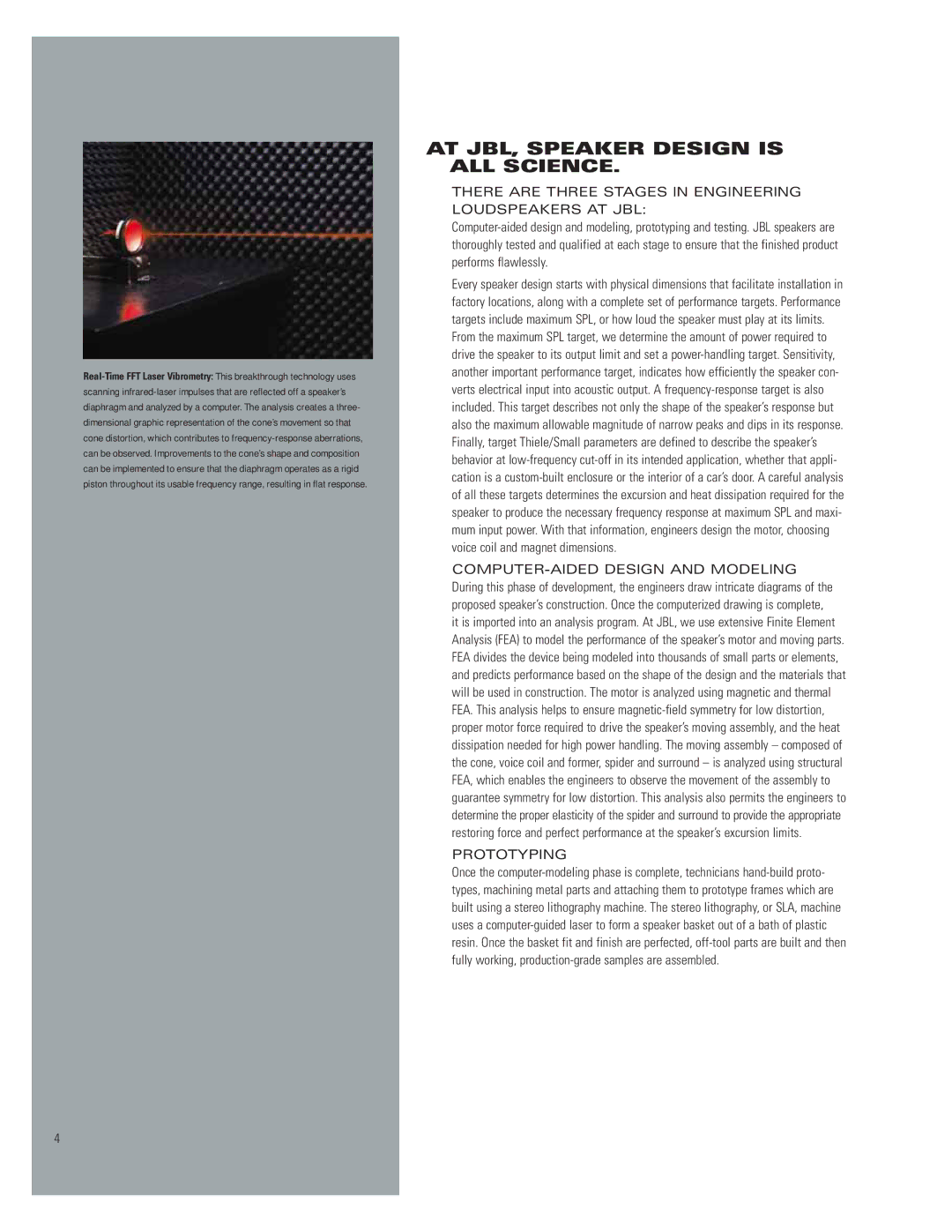Real-Time FFT Laser Vibrometry: This breakthrough technology uses scanning infrared-laser impulses that are reflected off a speaker’s diaphragm and analyzed by a computer. The analysis creates a three- dimensional graphic representation of the cone’s movement so that cone distortion, which contributes to frequency-response aberrations, can be observed. Improvements to the cone’s shape and composition can be implemented to ensure that the diaphragm operates as a rigid piston throughout its usable frequency range, resulting in flat response.
AT JBL, SPEAKER DESIGN IS ALL SCIENCE.
THERE ARE THREE STAGES IN ENGINEERING LOUDSPEAKERS AT JBL:
Computer-aided design and modeling, prototyping and testing. JBL speakers are thoroughly tested and qualified at each stage to ensure that the finished product performs flawlessly.
Every speaker design starts with physical dimensions that facilitate installation in factory locations, along with a complete set of performance targets. Performance targets include maximum SPL, or how loud the speaker must play at its limits.
From the maximum SPL target, we determine the amount of power required to drive the speaker to its output limit and set a power-handling target. Sensitivity, another important performance target, indicates how efficiently the speaker con- verts electrical input into acoustic output. A frequency-response target is also included. This target describes not only the shape of the speaker’s response but also the maximum allowable magnitude of narrow peaks and dips in its response. Finally, target Thiele/Small parameters are defined to describe the speaker’s behavior at low-frequency cut-off in its intended application, whether that appli- cation is a custom-built enclosure or the interior of a car’s door. A careful analysis of all these targets determines the excursion and heat dissipation required for the speaker to produce the necessary frequency response at maximum SPL and maxi- mum input power. With that information, engineers design the motor, choosing voice coil and magnet dimensions.
COMPUTER-AIDED DESIGN AND MODELING During this phase of development, the engineers draw intricate diagrams of the proposed speaker’s construction. Once the computerized drawing is complete, it is imported into an analysis program. At JBL, we use extensive Finite Element Analysis (FEA) to model the performance of the speaker’s motor and moving parts. FEA divides the device being modeled into thousands of small parts or elements, and predicts performance based on the shape of the design and the materials that will be used in construction. The motor is analyzed using magnetic and thermal FEA. This analysis helps to ensure magnetic-field symmetry for low distortion, proper motor force required to drive the speaker’s moving assembly, and the heat dissipation needed for high power handling. The moving assembly – composed of the cone, voice coil and former, spider and surround – is analyzed using structural FEA, which enables the engineers to observe the movement of the assembly to guarantee symmetry for low distortion. This analysis also permits the engineers to determine the proper elasticity of the spider and surround to provide the appropriate restoring force and perfect performance at the speaker’s excursion limits.
PROTOTYPING
Once the computer-modeling phase is complete, technicians hand-build proto- types, machining metal parts and attaching them to prototype frames which are built using a stereo lithography machine. The stereo lithography, or SLA, machine uses a computer-guided laser to form a speaker basket out of a bath of plastic resin. Once the basket fit and finish are perfected, off-tool parts are built and then fully working, production-grade samples are assembled.

